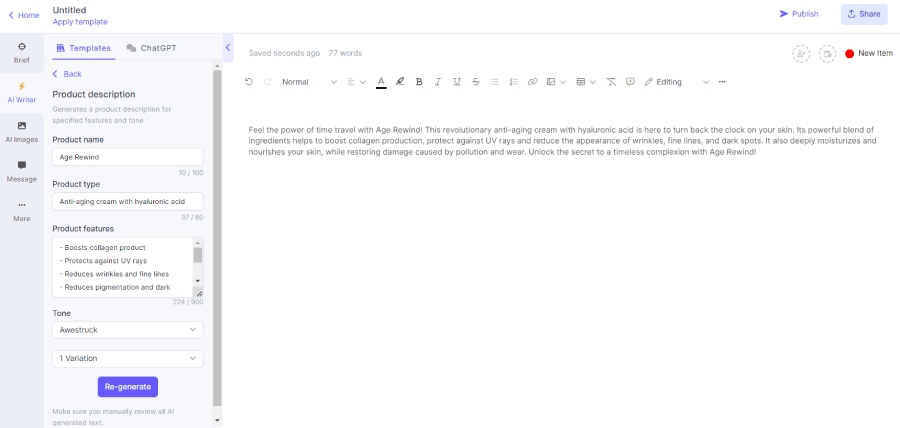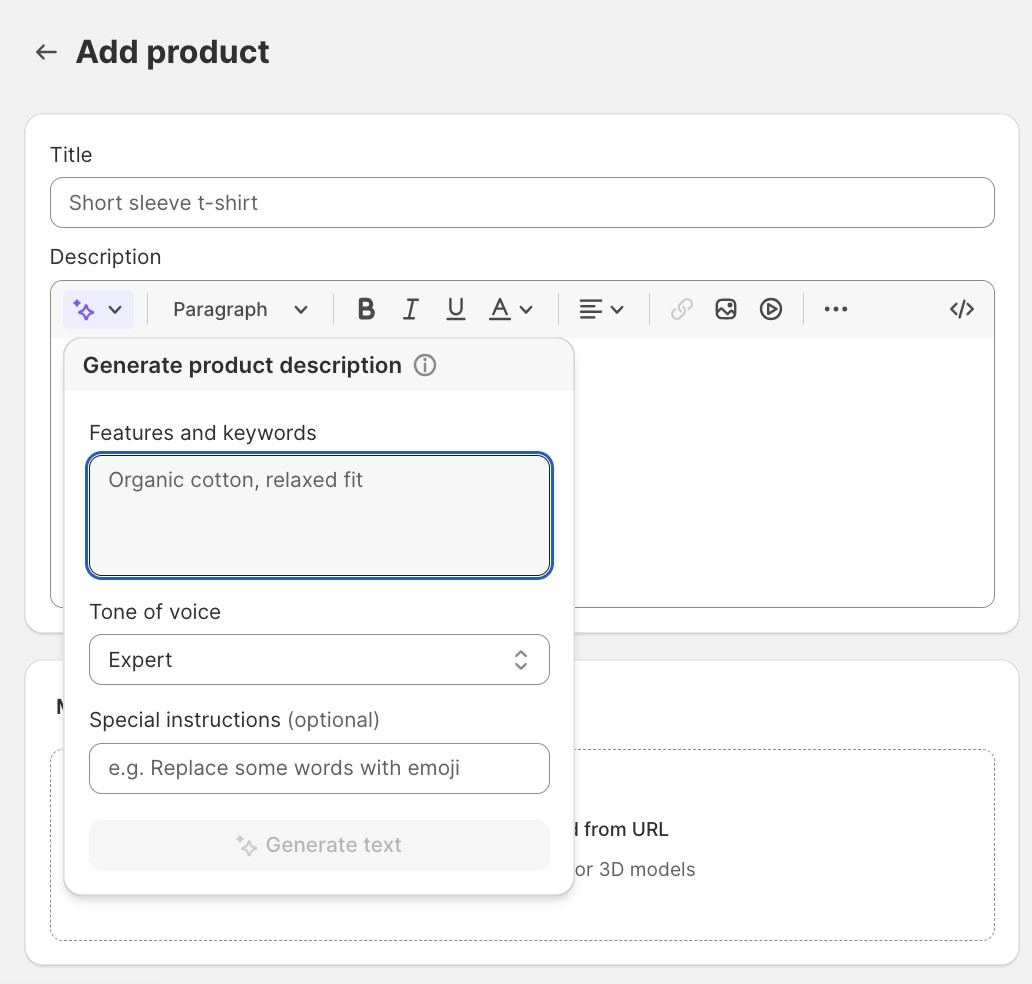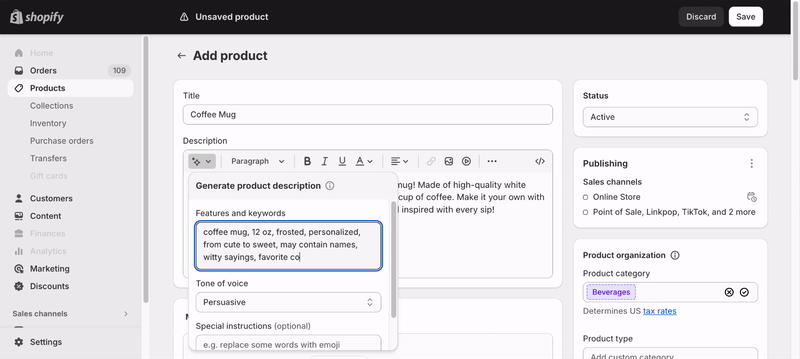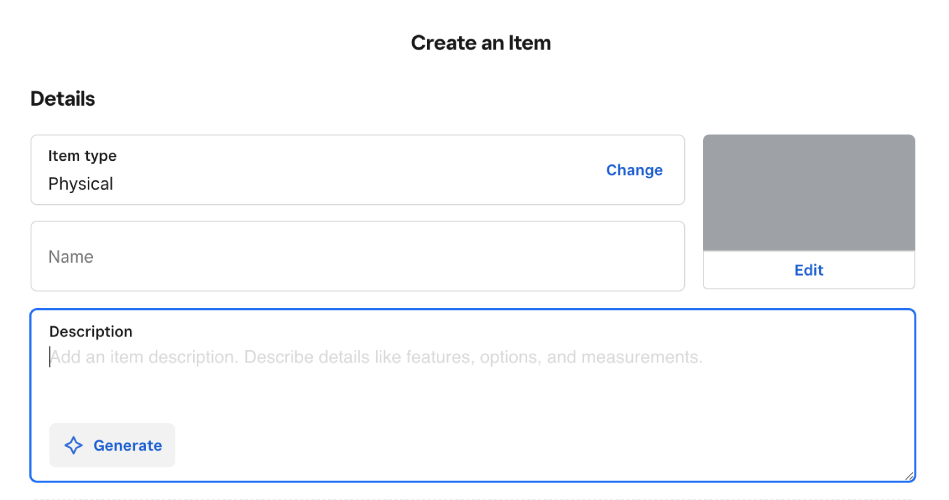Using AI-generated product descriptions is a relatively new approach but is gaining traction and popularity. Small businesses seeking to streamline their ecommerce operations and increase their online sales can definitely benefit from using AI tools for their product descriptions.
But while using product description generators can be timesavers, it depends on how much, how often, and how good the inputs are. In short, a product description generator can only be as good as your prompts.
We take a look at how this software works and its pros and cons. We also discuss best practices so you can use AI to write product descriptions that retain your brand’s voice and help you stand out from the competition.
What Is an AI Product Description Generator?
An AI product description generator is an artificial intelligence (AI) software that uses natural language processing (NLP) to automatically write product descriptions for ecommerce platforms. It is an innovative tool that uses advanced algorithms to efficiently produce engaging content for ecommerce listings.

An example of an AI product description generator (Source: Writesonic)
AI has long been used in content marketing and there are a lot of free tools available online. It is a more recent development—around early 2023—that the technology was integrated into ecommerce platforms to generate product descriptions:
- Last year, Shopify rolled out Shopify Magic, a suite of generative AI tools meant to help small businesses speed up processes, including crafting product descriptions.
- This was soon followed by Square’s generative AI features for Square Online.
- BigCommerce has partnered with Google to provide AI-powered product enhancements.
- Even ecommerce giant Amazon launched AI product description generators for sellers.
How AI Product Description Generators Work
While many ecommerce platforms now have built-in AI features, you can also use browser-based tools to generate your product descriptions. We check out both options below:
Browser-based Tools
Browser-based tools like ChatGPT are mostly free and easy to use, and generating product descriptions is a straightforward task. Simply submit product features, input keywords you want used in the description, and specify what type of writing you want—concise, detailed, engaging, and more.
The only difference between these tools is how much you can customize your prompts. Some tools allow you to specify the tone, number of paragraphs, and language used.

(Source: Narrato)
Some AI product description generators you can work with are Writesonic, Narrato, and AISEO. There are also free tools like Ahrefs, Copy.ai, and Frase.io.
Related:
- 7 Best AI Content Generation Tools for Content, SEO, Images & More
- 8 Best AI Content Writers for Small Business Marketing
- 8 Best AI Marketing Tools for Small Businesses Right Now
Built-in Tools for Ecommerce Platforms
Generating product descriptions through a platform’s built-in AI tools is a similar process to using AI for generating other content—you only need to click on the AI feature to create your product descriptions.
For example, this is how AI product description generation works in Shopify. To generate a product description, go to your dashboard and click Add Product. You can find the Shopify Magic icon (stars icon) in the toolbar. Simply click on it to start using it.

Here’s how it worked when I tried it when I was testing and building a Shopify demo store. I entered keywords, and features I wanted highlighted, added special instructions like adding an emoji, and toggled between voice tones (expert, daring, playful, sophisticated, persuasive, supportive, or specific/custom tones—this is up to you!). From there, Shopify Magic does its “magic.” You can keep the generated text and further edit it as you wish.

Square Online is the same. I went into the Square dashboard, clicked on Create An Item, and tapped the Generate button inside the Description box. Note that it doesn’t appear until you have your cursor in the box.

For an apples-to-apples comparison, I generated the same product with the same descriptions. While the generated product description is more or less the same as Shopify’s, Square has fewer prompts for you to fill in when it comes to tone—concise, engaging, or professional. However, Square lets you set whether you want a short, medium, or long form of copy.

Pros & Cons of Using Product Description Generators
Crafting product descriptions is not always the strongest asset of a business owner—that’s why they hire copywriters for the job. However, it can eat away into the budget, especially for those just starting out or operating on a limited team. Instead of just using the product description given by manufacturers or wholesalers, going with AI product descriptions can help compel site visitors to purchase.
Some benefits to using AI product description generators include:
- Saves time and resources: Using these tools definitely helps small businesses save time and resources and increases the efficiency of creating product descriptions that sell. If you have a large inventory to upload for an upcoming product launch or sale, using these can help you create personalized descriptions for each product in less time.
- Help retain consistency in tone and language across the website: Since you can customize product descriptions and set the tone you want them to be, you can maintain the same tone throughout your products without having to think about using the same words or phrases.
- Can help improve search engine optimization (SEO) and search ranking: You can optimize AI-generated product descriptions for search engine rankings by including relevant keywords and phrases. In turn, you increase your search visibility and attract more website traffic.
While AI product description generators seem too good to be true, they certainly have their limitations too. These are the limitations of an AI product description generator:
- Limited creativity in language and style: Human touch adds creativity and flair to product descriptions. Since these are generated by algorithms and highly dependent on prompts, product descriptions may lack creativity or appear redundant or too flowery. You can start product descriptions on these tools and edit them off as you see fit, to save time coming up with ideas from scratch.
- Lack of personalization: Since these are based on data and rules set by algorithms, product descriptions may not be as personalized or unique as descriptions written by humans. This poses a challenge for businesses since they won’t be able to differentiate themselves from competitors or set a strong brand voice.
- May not work for niche or specialized products: Highly niched products, such as medical equipment or automobile parts, may have complex features that need to be described in a specific way. AI tools may not be able to explain this as it is only using algorithms for product descriptions.
Best Practices in Using AI Product Description Generators
AI can only be as good as the one operating it—so its output will still greatly depend on how detailed your inputs are. Implement the following best practices to truly leverage the power of AI to enhance your product descriptions.
- Be as specific as possible when entering product features because expertise is necessary for a product description generator to provide high-quality results.
- Do keyword research to ensure you are optimizing for SEO and concentrating on the most relevant searches for your products.
- Have your customer in mind when generating prompts. To ensure your product descriptions appeal to your target audience, create a shopper profile that includes a brand tone and common phrases that appeal to them.
- Combine with human-written content. Don’t forget to still include the human touch. Consider using AI-generated descriptions for your usual products and human-written descriptions for higher-end products, bestsellers, and fast-selling items. See our guide to writing high-quality product descriptions.
- Constantly test and analyze the performance of the generated product descriptions to see which areas can be improved. For example, setting a tone for a set of products for a week and changing them the next so you can track conversion rates and see which ones perform better.
Bottom Line
AI will continue to impact ecommerce and product description generation is just the tip of the iceberg. While AI product description generators can be a huge productivity booster and sales converter, remember that this technology can only be as good as your prompts are. Employing best practices for using the tool can help small businesses leverage the power of AI.